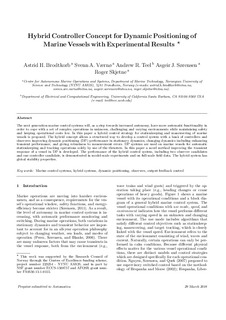| dc.contributor.author | Brodtkorb, Astrid H. | |
| dc.contributor.author | Værnø, Svenn Are Tutturen | |
| dc.contributor.author | Teel, Andrew R. | |
| dc.contributor.author | Sørensen, Asgeir Johan | |
| dc.contributor.author | Skjetne, Roger | |
| dc.date.accessioned | 2019-01-31T08:18:41Z | |
| dc.date.available | 2019-01-31T08:18:41Z | |
| dc.date.created | 2018-09-27T13:40:46Z | |
| dc.date.issued | 2018 | |
| dc.identifier.citation | Automatica. 2018, 93 489-497. | nb_NO |
| dc.identifier.issn | 0005-1098 | |
| dc.identifier.uri | http://hdl.handle.net/11250/2583240 | |
| dc.description.abstract | The next generation marine control systems will, as a step towards increased autonomy, have more automatic functionality in order to cope with a set of complex operations in unknown, challenging and varying environments while maintaining safety and keeping operational costs low. In this paper a hybrid control strategy for stationkeeping and maneuvering of marine vessels is proposed. The hybrid concept allows a structured way to develop a control system with a bank of controllers and observers improving dynamic positioning (DP) performance in stationary dynamics, changing dynamics including enhancing transient performance, and giving robustness to measurement errors. DP systems are used on marine vessels for automatic stationkeeping and tracking operations solely by use of the thrusters. In this paper a novel method improving the transient response of a vessel in DP is developed. The performance of the hybrid control system, including two observer candidates and one controller candidate, is demonstrated in model-scale experiments and on full-scale field data. The hybrid system has global stability properties. | nb_NO |
| dc.language.iso | eng | nb_NO |
| dc.publisher | Elsevier | nb_NO |
| dc.rights | Attribution-NonCommercial-NoDerivatives 4.0 Internasjonal | * |
| dc.rights.uri | http://creativecommons.org/licenses/by-nc-nd/4.0/deed.no | * |
| dc.title | Hybrid controller concept for dynamic positioning of marine vessels with experimental results | nb_NO |
| dc.title.alternative | Hybrid controller concept for dynamic positioning of marine vessels with experimental results | nb_NO |
| dc.type | Journal article | nb_NO |
| dc.type | Peer reviewed | nb_NO |
| dc.description.version | acceptedVersion | nb_NO |
| dc.source.pagenumber | 489-497 | nb_NO |
| dc.source.volume | 93 | nb_NO |
| dc.source.journal | Automatica | nb_NO |
| dc.identifier.doi | 10.1016/j.automatica.2018.03.047 | |
| dc.identifier.cristin | 1614935 | |
| dc.relation.project | Norges forskningsråd: 223254 | nb_NO |
| dc.description.localcode | © 2018. This is the authors’ accepted and refereed manuscript to the article. Locked until 12.4.2020 due to copyright restrictions. This manuscript version is made available under the CC-BY-NC-ND 4.0 license http://creativecommons.org/licenses/by-nc-nd/4.0/ | nb_NO |
| cristin.unitcode | 194,64,20,0 | |
| cristin.unitname | Institutt for marin teknikk | |
| cristin.ispublished | true | |
| cristin.fulltext | postprint | |
| cristin.qualitycode | 2 | |

